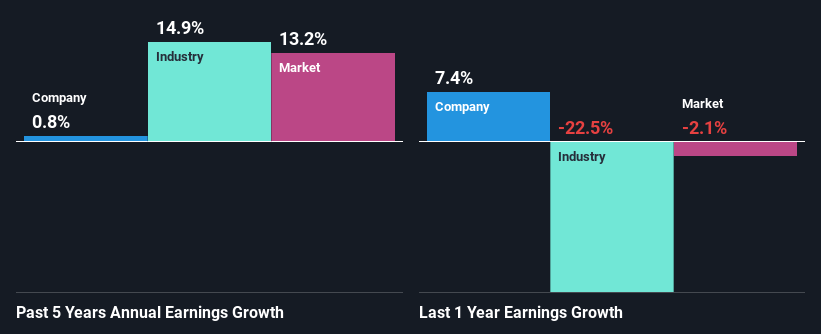Is Smith & Wesson Brands, Inc.'s (NASDAQ:SWBI) Recent Price Movement Underpinned By Its Weak Fundamentals?
With its stock down 17% over the past three months, it is easy to disregard Smith & Wesson Brands (NASDAQ:SWBI). We, however decided to study the company's financials to determine if they have got anything to do with the price decline. Long-term fundamentals are usually what drive market outcomes, so it's worth paying close attention. Specifically, we decided to study Smith & Wesson Brands' ROE in this article.
Return on equity or ROE is a key measure used to assess how efficiently a company's management is utilizing the company's capital. In simpler terms, it measures the profitability of a company in relation to shareholder's equity.
See our latest analysis for Smith & Wesson Brands
How To Calculate Return On Equity?
ROE can be calculated by using the formula:
Return on Equity = Net Profit (from continuing operations) ÷ Shareholders' Equity
So, based on the above formula, the ROE for Smith & Wesson Brands is:
9.9% = US$40m ÷ US$398m (Based on the trailing twelve months to April 2024).
The 'return' refers to a company's earnings over the last year. So, this means that for every $1 of its shareholder's investments, the company generates a profit of $0.10.
What Has ROE Got To Do With Earnings Growth?
We have already established that ROE serves as an efficient profit-generating gauge for a company's future earnings. Depending on how much of these profits the company reinvests or "retains", and how effectively it does so, we are then able to assess a company’s earnings growth potential. Assuming everything else remains unchanged, the higher the ROE and profit retention, the higher the growth rate of a company compared to companies that don't necessarily bear these characteristics.
A Side By Side comparison of Smith & Wesson Brands' Earnings Growth And 9.9% ROE
When you first look at it, Smith & Wesson Brands' ROE doesn't look that attractive. Next, when compared to the average industry ROE of 15%, the company's ROE leaves us feeling even less enthusiastic. Hence, the flat earnings seen by Smith & Wesson Brands over the past five years could probably be the result of it having a lower ROE.
We then compared Smith & Wesson Brands' net income growth with the industry and found that the company's growth figure is lower than the average industry growth rate of 15% in the same 5-year period, which is a bit concerning.
Earnings growth is a huge factor in stock valuation. The investor should try to establish if the expected growth or decline in earnings, whichever the case may be, is priced in. By doing so, they will have an idea if the stock is headed into clear blue waters or if swampy waters await. Has the market priced in the future outlook for SWBI? You can find out in our latest intrinsic value infographic research report.
Is Smith & Wesson Brands Using Its Retained Earnings Effectively?
Smith & Wesson Brands has a low three-year median payout ratio of 21% (or a retention ratio of 79%) but the negligible earnings growth number doesn't reflect this as high growth usually follows high profit retention.
Moreover, Smith & Wesson Brands has been paying dividends for four years, which is a considerable amount of time, suggesting that management must have perceived that the shareholders prefer dividends over earnings growth.
Summary
Overall, we have mixed feelings about Smith & Wesson Brands. While the company does have a high rate of reinvestment, the low ROE means that all that reinvestment is not reaping any benefit to its investors, and moreover, its having a negative impact on the earnings growth. Up till now, we've only made a short study of the company's growth data. So it may be worth checking this free detailed graph of Smith & Wesson Brands' past earnings, as well as revenue and cash flows to get a deeper insight into the company's performance.
Have feedback on this article? Concerned about the content? Get in touch with us directly. Alternatively, email editorial-team (at) simplywallst.com.
This article by Simply Wall St is general in nature. We provide commentary based on historical data and analyst forecasts only using an unbiased methodology and our articles are not intended to be financial advice. It does not constitute a recommendation to buy or sell any stock, and does not take account of your objectives, or your financial situation. We aim to bring you long-term focused analysis driven by fundamental data. Note that our analysis may not factor in the latest price-sensitive company announcements or qualitative material. Simply Wall St has no position in any stocks mentioned.
Have feedback on this article? Concerned about the content? Get in touch with us directly. Alternatively, email editorial-team@simplywallst.com

 Yahoo Finance
Yahoo Finance 
